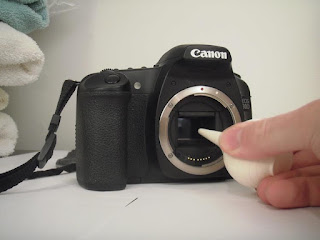Some things are just universally embarrassing. Among these certain situations is getting caught with dirty pictures. No, not that kind of dirty picture, but, literally, a dirty picture where there are dark spots in the image caused by dirt on your sensor. So how does one go about preventing perfectly good pictures being ruined by dirt?
Camera sensors (top) are dust magnets against which mirrors (bottom) offer little protection)
One answer: never change the lens on your camera. In theory, this should do a good job at keeping dust out of your camera and off the sensor. Unfortunately, most lenses are not gasketed against dust/moisture intrusion, so even limiting yourself to one lens may not do the trick if you shoot in dusty conditions. Besides that, who wants to use only one lens, anyway?
Answer two: fancy (sometimes expensive) gimmicks. The reason that digital SLRs are so prone to having dust problems is the fact that the sensors are statically charged, which can attract dust,. Especially when the lens is being switched. This commonsense notion has led many profiteers to market gimmicky, over-priced devices for the express purpose of cleaning crud off of your camera's sensor. If you were to look around online for camera cleaning devices, you would find tiny Swiffers, mini vacuum cleaners, over-prced rubber blowers, brushes, and other stuff. What do these all have in common? They're for people who have more money than brains.
So what can be used to clean well and also on the cheap?
So what can be used to clean well and also on the cheap?
Just hold the syring near the sensor and puff away.
First, the common ear syringe. An ear syringe is just like one of those dedicated sensor blower things that will commonly sell for $10-20. In contrast, the ear syringe does exactly the same thing and can be had for a few bucks at the local drug store. Simply hold the syringe near the sensor and squeeze the bulb, sending a puff of air onto the sensor to dislodge the dust. Unfortunately, some specks of dust adhere themselves unusually well and cannot be blasted off the sensor's surface. This brings us to our next economical dust removal device: compressed air.
Compressed air (top) is even better, just shake the can and spray of the sensor (bottom)
A can of compressed air will typically run a couple of bucks for a small one to maybe $5 for one the size of the average spray paint can. Far more powerful than the ear syringe, the windy can is sure to blast away anything the wimpy syringe misses. Whatever you do, don't shake the can up too much and leave the straw off the nozzle. Even one shake should be more than enough power to clean the sensor and as for the straw, they can easily pop off the nozzle and it sure would stink to have your camera's sensor ruined by a flying straw! Oh yes, the compressed air can also work on computers, CD players, and just about anything else, too.
In conclusion, both the ear syringe and the compressed air can clean your camera sensor without touching it (unlike the mini Swiffer, where one bad swipe can cause permanent damage) and not cost a relative fortune (like the blower and tiny vacuum). So, feel free to change your lenses and broaden your photographic horizons as there is really no reason to be afraid of a little dust.
Like What You Just Read?
Why not check out other great stuff about photography, astronomy, associated gear, and how to use it.
Think someone else would find this informative (or at least entertaining)? Use the buttons below to share!
Why not check out other great stuff about photography, astronomy, associated gear, and how to use it.
Think someone else would find this informative (or at least entertaining)? Use the buttons below to share!





















No comments:
Post a Comment